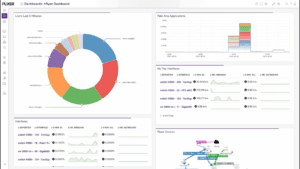As traditional perimeter-based defenses prove inadequate against today’s cyber threats, Zero Trust offers a flexible and comprehensive model grounded in the principle of “never trust, always verify.” This approach treats every access request as potentially malicious, regardless of the user’s location or prior authentication, shifting the security focus from network perimeters to individual identities, devices, and behaviors.
What is Zero Trust?
Unlike conventional security models built on the “castle-and-moat” philosophy, where internal traffic is implicitly trusted, Zero Trust continuously authenticates and authorizes every request. Traditional models often grant excessive access once a user enters the network, allowing lateral movement for attackers who breach the perimeter. In contrast, Zero Trust enforces strict access controls based on user identity, device posture, contextual data, and behavioral signals, minimizing exposure and limiting damage.
The push for Zero Trust is driven by a confluence of technological shifts and evolving threats. Cloud infrastructure has dissolved the once-clear perimeter, with organizations relying on distributed architectures that demand robust, context-aware access policies. Shared responsibility between cloud providers and users complicates security, requiring granular, policy-driven control over who can access what.
Simultaneously, the explosion of third-party SaaS and PaaS tools has expanded the attack surface. Organizations can no longer assume these external systems are secure. Zero Trust principles counteract these risks through continuous verification and least privilege access.
Remote and hybrid workforces, however, have added to the complexity. Employees, contractors, and partners access company resources from a multitude of devices and locations, making traditional models of network-based trust insufficient. As APTs and insider risks become more sophisticated, Zero Trust provides a robust framework for monitoring, detection, and access management.
Principles and Architecture of Zero Trust
Zero Trust is governed by a set of interlocking principles:
- Never trust, always verify: Treat every access request as untrusted until fully authenticated and authorized.
- Least privilege access: Users receive only the permissions necessary to perform their roles, enforced through role-based access control, just-in-time access, just-enough access.
- Assume breach: Build systems as if compromise has already occurred, using segmentation, encryption, and visibility tools to contain threats.
- Continuous verification: Access is not a one-time check; it is evaluated throughout a session based on user behavior and device health.
These principles are enabled by a range of architectural components:
- Identity and Access Management (IAM) provides core authentication and authorization, using SSO, MFA, and identity governance.
- Secure Access Service Edge (SASE) virtualizes and centralizes network and security functions like ZTNA, firewalls, and secure web gateways.
- Data Loss Prevention (DLP) monitors and controls sensitive data in motion and at rest.
- Micro-segmentation divides the network into isolated zones, preventing lateral movement in case of a breach.
- Network observability tools ensure constant visibility, flag anomalies, and automate responses.
Implementing Zero Trust: A Phased Approach
Successfully adopting Zero Trust requires careful planning and incremental deployment. A phased strategy allows organizations to modernize without disrupting operations.
Phase 1: Assessment and Planning
Begin by identifying your “protect surface”—the highest-priority assets such as sensitive data, critical applications, and essential systems. Use advanced asset discovery and classification tools to map these.
Next, analyze transaction flows. Understand how data moves between users, devices, and applications to identify dependencies and potential vulnerabilities. Network Traffic Analysis (NTA) can help visualize these flows.
A baseline assessment of your current security posture will reveal gaps in coverage, outdated protocols, and unnecessary access privileges.
Phase 2: Architecture and Policy Development
With assets and flows mapped, design your Zero Trust architecture using SDN, VLANs, and firewalls to implement micro-segmentation. Policies should be developed using a comprehensive methodology like the Kipling Method, which asks the “who, what, when, where, why, and how” of each access request.
Access should be governed by real-time, risk-based rules that consider user behavior, device health, location, and role.
Phase 3: Technology Rollout
Deploy IAM with MFA and SSO, followed by micro-segmentation to isolate critical zones. Ensure endpoint compliance with up-to-date antivirus and security patches. Non-compliant devices should be flagged or denied access.
Implement an observability platform for real-time threat detection. AI and machine learning tools automate risk scoring and accelerate incident response.
Phase 4: Monitoring and Optimization
Continuous monitoring is essential. Establish baseline behaviors for users and devices, and flag deviations. Use automated playbooks to respond to incidents.
Perform regular red-team exercises, vulnerability scans, and penetration testing to refine defenses. User training should reinforce security awareness and educate staff on new protocols.
Overcoming Challenges
Implementing Zero Trust is not without hurdles. Legacy systems often lack the APIs or security protocols needed for integration. Middleware solutions can bridge the gap, but in some cases, upgrading may be necessary.
Micro-segmentation in traditional networks may disrupt service if implemented hastily. Organizations must take a gradual, test-driven approach to avoid downtime.
Cultural resistance is another challenge. Employees may see increased verification as intrusive. Adaptive authentication can help ease adoption by creating only minimal friction for low-risk requests.
Budget and staffing constraints can slow down deployment. However, Zero Trust’s long-term return on investment, from breach prevention to operational efficiency, often outweighs upfront costs.
Evaluating Vendors and Solutions
Choosing the right Zero Trust solution involves technical, strategic, and financial considerations. Look for:
- Robust identity protection, including service account management and defense against credential theft.
- Integration with SIEM, SOAR, email systems, and legacy platforms.
- Support for unmanaged devices such as contractor laptops or IoT endpoints.
- Scalability, so your Zero Trust infrastructure grows with your organization.
Vendor evaluations should involve proof-of-concept testing, RFPs with detailed criteria, and reference checks with organizations of similar size and industry.
Managing Insider Threats with Zero Trust
Insider threats, whether malicious or negligent, account for a significant percentage of breaches. Zero Trust mitigates these through continuous monitoring, risk-based access, and least privilege.
Privileged Access Management (PAM) systems integrated into Zero Trust grant administrators temporary access based on need, context, and risk profile. Session logging and behavioral analytics ensure oversight. Even if a credential is compromised, adaptive policies can detect abnormal behavior and shut down access.
Micro-segmentation limits lateral movement, and endpoint privilege management reduces the risk of sensitive data exfiltration.
Concluding Thoughts
Zero Trust is a cybersecurity strategy that reflects the reality of today’s distributed, complex, and threat-laden environments.
By focusing on principles like least privilege, continuous verification, and micro-segmentation, Zero Trust offers a way to reduce risk and improve visibility across diverse IT environments. Its implementation is not without challenges, but when approached incrementally and strategically, it can provide meaningful improvements in organizational security posture.
This model is not a silver bullet, nor is it universally applicable in the same way for every organization. The effectiveness of Zero Trust depends on proper planning, integration with existing systems, and a clear understanding of the organization’s unique infrastructure and risk profile. Ultimately, understanding Zero Trust helps stakeholders make informed decisions about how best to secure modern digital operations.
If you’re looking to ensure that your environment’s segmentation is working as intended, check out our webinar on effective segmentation verification.



